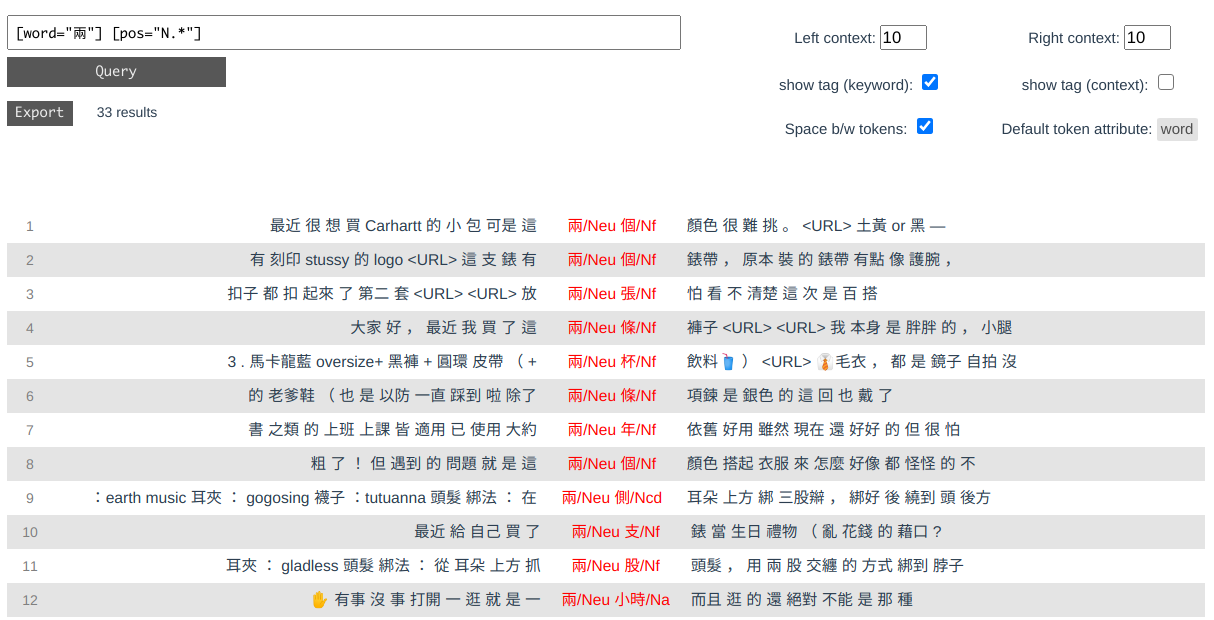https://github.com/liao961120/concordancer
Searching in-memory corpus with Corpus Query Language (CQL)
https://github.com/liao961120/concordancer
concordancer corpus-query-language corpus-tools python3
Last synced: 6 months ago
JSON representation
Searching in-memory corpus with Corpus Query Language (CQL)
- Host: GitHub
- URL: https://github.com/liao961120/concordancer
- Owner: liao961120
- Created: 2020-12-04T13:05:57.000Z (almost 5 years ago)
- Default Branch: main
- Last Pushed: 2024-12-02T05:41:17.000Z (11 months ago)
- Last Synced: 2025-04-12T02:43:49.070Z (7 months ago)
- Topics: concordancer, corpus-query-language, corpus-tools, python3
- Language: Python
- Homepage: https://yongfu.name/concordancer/
- Size: 32.3 MB
- Stars: 19
- Watchers: 1
- Forks: 3
- Open Issues: 3
-
Metadata Files:
- Readme: README.md
Awesome Lists containing this project
README

# Concordancer
This library loads and indexes a corpus in RAM and provides concordance search to retrieve data from the corpus with (a subset of) Corpus Query Language (CQL).
## Installation
```bash
pip install -U concordancer
```
## Usage
[Concordancer](https://github.com/liao961120/concordancer) is designed with this workflow in mind:

The user is expected to preprocess the text data to match the corpus data required by ``concordancer``. Once this is done, subsequent tasks such as indexing the copus, writing query functions to search the corpus, and displaying results in an aligned keyword-in-context format are all done by ``concordancer``. The user could then further process the search results (exported as JSON by ``concordancer``) for other uses.
### Input corpus data structure
``concordancer`` requires the corpus to be structured (minimally) as:
```python
[ # a corpus
{ # a text
'text': [
[, , , ...], # a sentence in a text
[, , , ...], # another sentence in a text
...
[, , , ...] # the last sentence in a text
]
},
{...}, # another text
...
]
```
where `` is a dictionary representating a token, which may resemble something like:
```python
{
'word': 'hits',
'lemma': 'hit',
'pos': 'V'
}
```
This structure allows the corpus to be saved conveniently as a [newline-delimited JSON](https://jsonlines.org) file (`.jsonl`), where each line of the file corresponds to a single text in the corpus, represented as a JSON object (i.e., a dictionary in Python). You can see an example of the corpus file saved in `.jsonl` [here](https://github.com/liao961120/concordancer/blob/main/example-corpus-data/tokenDict.jsonl). The code below uses a corpus saved in `.jsonl` format for demonstration.
### Loading a corpus from file
The code below uses an [example corpus](https://github.com/liao961120/concordancer/tree/main/test-data), which is saved as a **newline-delimited JSON** file (described in the previous section).
```python
import json
from concordancer.demo import download_demo_corpus
from concordancer.concordancer import Concordancer
from concordancer import server
# Load demo corpus
fp = download_demo_corpus(to="~/Desktop")
with open(fp, encoding="utf-8") as f:
corpus = [ json.loads(l) for l in f ]
# Index and initiate the corpus as a concordancer object
C = Concordancer(corpus)
C.set_cql_parameters(default_attr="word", max_quant=3)
```
### Interactive Search Interface
You can start an interactive server to query and read results through your browser:
```python
>>> server.run(C)
Initializing server...
Start serving at http://localhost:1420
```

### CQL Concordance search
Alternatively, you can work with the `Concordancer` object, which allows you to send CQL queries to the corpus:
```python
cql = '''
verb:[pos="V.*"] noun:[pos="N[abch]"]
'''
concord_list = C.cql_search(cql, left=2, right=2)
```
The results of a query is returned as a generator, which can be converted to a list of dictionaries (and then to JSON or other data structures for further uses):
```python
>>> concord_list = list(concord_list)
>>> concord_list[:2]
[
{
'left': [{'word': '買', 'pos': 'VC'}, {'word': '了', 'pos': 'Di'}],
'keyword': [{'word': '覺得', 'pos': 'VK'}, {'word': '材質', 'pos': 'Na'}],
'right': [{'word': '很', 'pos': 'Dfa'}, {'word': '對', 'pos': 'VH'}],
'position': {'doc_idx': 78, 'sent_idx': 13, 'tk_idx': 9},
'captureGroups': {'verb': [{'word': '覺得', 'pos': 'VK'}],
'noun': [{'word': '材質', 'pos': 'Na'}]}
},
{
'left': [{'word': '“', 'pos': 'PARENTHESISCATEGORY'},
{'word': '不', 'pos': 'D'}],
'keyword': [{'word': '戴', 'pos': 'VC'}, {'word': '錶', 'pos': 'Na'}],
'right': [{'word': '世代', 'pos': 'Na'}, {'word': '”', 'pos': 'VC'}],
'position': {'doc_idx': 52, 'sent_idx': 7, 'tk_idx': 36},
'captureGroups': {'verb': [{'word': '戴', 'pos': 'VC'}],
'noun': [{'word': '錶', 'pos': 'Na'}]}
}
]
```
### Keyword in Context
To better read the concordance lines, pass `concord_list` into `concordancer.kwic_print.KWIC()` to print them as a keyword-in-context format in the console:
```python
>>> from concordancer.kwic_print import KWIC
>>> KWIC(concord_list[:5])
left keyword right LABEL: verb LABEL: noun
-------------------------- --------------- ---------------- ------------- -------------
買/VC 了/Di 覺得/VK 材質/Na 很/Dfa 對/VH 覺得/VK 材質/Na
“/PARENTHESISCATEGORY 不/D 戴/VC 錶/Na 世代/Na ”/VC 戴/VC 錶/Na
聯名鞋/Na 趁著/P 過年/VA 期間/Na 穿出去/VB 四處/D 過年/VA 期間/Na
走/VA /WHITESPACE 燒/VC 錢/Na 啊/T ~/FW 燒/VC 錢/Na
正/VH 韓/Nc 賣/VD 家/Nc 裡面/Ncd 很/Dfa 賣/VD 家/Nc
```
## Supported CQL features
CQL search is supported through [cqls](https://github.com/liao961120/cqls), which implements a (quite useful) subset of CQL:
- token: `[]`, `"我"`, `[word="我"]`, `[word!="我" & pos="N.*"]`
- token-level quantifier: `+`, `*`, `?`, `{n,m}`
- grouping: `("a" "b"? "c"){1,2}`
- label: `lab1:[word="我" & pos="N.*"] lab2:("a" "b")`